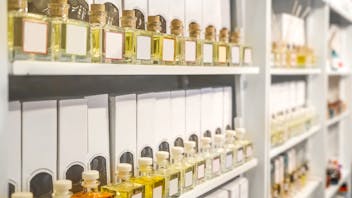Product Overview
Our gorgeous Orris Butter (15% irones), a rare essential oil distilled from the rhizomes of Iris pallida, has a delicate, sweet, warm, powdery-floral aroma reminiscent of violet flowers with mellow woody undertones. This material is very tenacious, has excellent fixative value, and displays its full and impressive strength and diffusion in the dry down, especially when it is highly diluted.
Orris Butter essential oil is often incorrectly referred to as Orris Concrète because it is semi-solid at room temperature. This is due to the presence of myristic acid, the primary constituent in Orris[1, 2], a saturated fatty acid that is also present in palm and coconut oils.
The essential oil of Iris pallida is highly prized as a fixative and base note in high-end natural perfumery and is obtained from rhizomes that have been in the ground for three years, then dried and aged for three more years.[3] Orris rhizomes contain precursors of molecules called irones, whose intense, powerful odor develops only with time. It is during this six-year period that oxidative processes begin to yield irones – the pinnacles of natural perfumery – from which the extraordinary fragrance of Orris arises, making the oil from these roots a favored ingredient in perfumery since the 18th century.[4] While Arctander asserts that fresh Orris rhizomes are practically odorless,[5] according to Guenther, "Fresh orris roots …possess a rather disagreeable "green" and "herby" odor; whereas the dried roots, upon aging, develop a faint violet odor."[6] The high price of Orris Butter is a consequence of labor intensity, low yield and lengthy growth and storage times. Nearly 1,000 tons of fresh Iris rhizomes yield 300 tons after peeling, drying and powdering. One ton of the powder produces a mere 2 kilos of Orris Butter![7]
1 Lawless, Julia. Encyclopedia of Essential Oils, 2013, pp. 155-6.
2 Arctander, Steffen. Perfume and Flavor Materials of Natural Origin, 1960, p. 496.
3 Ibid.
4 Industry communication.
5 Arctander, Steffen. Perfume and Flavor Materials of Natural Origin, 1960, p. 496.
6 Guenther, Ernest. The Essential Oils, Vol. I, 1948, p. 111.
7 Industry communication.



